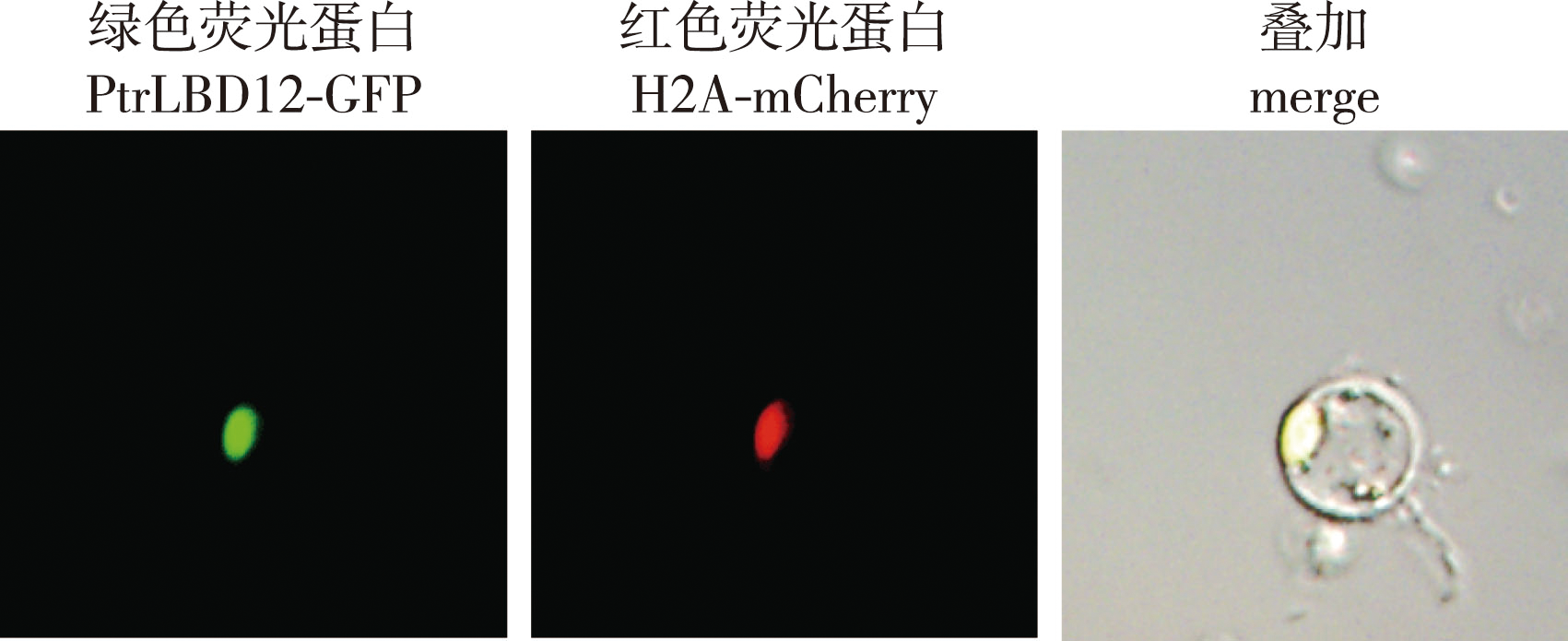【目的】创制毛果杨(Populus trichocarpa)LBD12(lateral organ boundaries domain 12)转录因子的过量表达植株,分析表型特征,初步探究PtrLBD12转录因子在毛果杨木材形成中的生物功能。【方法】基于前期的研究,筛选出了木材形成关键调控因子PtrbHLH186调控的下游转录因子PtrLBD12,通过基因克隆获得PtrLBD12基因;创制PtrLBD12过量表达毛果杨植株,测定并统计生长30、60、90 d毛果杨野生型和过表达植株的生长指标;对生长120 d的转基因及野生型植株各茎节进行石蜡切片、化学染色观察及不同细胞类型的统计分析;通过定量PCR测定过表达PtrLBD12基因对22个木质素单体合成酶基因表达水平的影响。【结果】获得毛果杨PtrLBD12过表达植株;与野生型相比,转基因植株的株高、地径等生长指标水平明显降低;纤维和导管细胞的数量显著增多,导管细胞的孔径减小,形成层细胞的形态结构无明显变化;木质素沉积水平增加,木质化程度增强;PtrLBD12的过量表达促进了木质素合成酶基因的表达。【结论】LBD12转录因子在毛果杨木材形成过程中发挥重要的调控作用,可调节木质素单体合成酶基因的表达,改变木质素沉积方式。此外,该基因也可以改变木质部细胞形态结构,影响植株生长发育。
【Objective】The formation of wood, one of the most important raw materials for pulp and energy, depends on a complex and precise transcriptional regulation process in which transcription factors figure prominently. In Populus trichocarpa, PtrLBD12 (lateral organ boundaries domain 12) is a transcription factor lying downstream of PtrbHLH186, a key regulator of wood formation. Hence, PtrLBD12 was studied in depth here to investigate its function in tree growth and wood formation.【Method】 To determine the role of the PtrLBD12 transcription factor in the growth and wood formation of poplar trees, we analyzed its expression characteristics, generated PtrLBD12 overexpressing plants of P. trichocarpa, and assessed the growth and wood formation traits of transgenic plants. (1) Xylem, phloem, and terminal bud and leaf samples of wild-type P. trichocarpa plants, cultivated in a greenhouse, were collected to extract their respective RNA. Next, transcriptome sequencing was done to analyze the patterns of differentially expressed genes in those distinct tissues, as well as their expression levels of PtrLBD12. (2) To clarify the expression pattern of the PtrLBD12 protein, its subcellular localization was investigated by using the transient transformation system of stem-differentiating xylem protoplasts of P. trichocarpa. (3) To create PtrLBD12-overexpressing plants, the Agrobacterium tumefaciens-mediated transformation system of P. trichocarpa was used, with transgenic plants identified at both the DNA and RNA level. (4) Plant stem height, ground (basal) stem diameter, number of stem nodes, and length of the 8th stem node of transgenic and wild-type plants were measured at 30, 60 and 90 days after planting. (5) The 2nd, 4th, 6th and 8th stem segments of overexpressing and wild-type greenhouse plants cultivated for 4 months were paraffin-sectioned. Their stem characteristics were then respectively observed via Safranin O/Fast Green and Toluidine Blue staining. LAS X V2.0 software was used to calculate the number of vessel and fiber cells, as well as average lumen area of vessel. (6) The relative expression levels of 22 monolignol biosynthetic pathway genes in the PtrLBD12-overexpressing plants were determined by using quantitative PCR and applying the 2△△Ct calculation.【Result】 (1) Transcriptome analysis of the xylem, phloem, and terminal bud and leaf tissues of P. trichocarpa revealed a higher expression level of PtrLBD12 in both the xylem and phloem. (2) Subcellular localization showed that PtrLBD12 was expressed in the nucleus, where transcription factors in general were found. (3) Three PtrLBD12 overexpressing transgenic lines of P. trichocarpa were obtained, whose relative expression levels were 40.91, 79.51 and 102.19. (4) Overexpressing PtrLBD12 adversely affected the normal growth and development of P. trichocarpa: plant height, ground stem diameter, number of stem nodes, and length of the 8th stem node all decreased significantly in transgenic plants vis-à-vis the wild type. (5) However, overexpression of PtrLBD12 did lead to significantly more vessel and fiber cells per unit of area in the stems of transgenic plants, but these vessels had smaller lumen area. Furthermore, the augmented expression of PtrLBD12 enhanced lignification of the plant stem. (6) Finally, PtrLBD12’s overexpression bolstered the expression levels of multiple genes in the monolignol biosynthetic pathway, namely PtrPAL1, PtrC4H1, PtrC4H2, PtrHCT6, PtrCSE, PtrCSE2, PtrCCoAOMT1, PtrCCoAOMT2, PtrCCoAOMT3, PtrCCR2 and PtrCAld5H1.【Conclusion】As the gene downstream of PtrbHLH186, a key regulator of wood formation in poplar, the LBD12 transcription factor is able to govern the expression of monolignol biosynthetic genes, change the mode of lignin deposition, alter the morphology of xylem cells, and thereby affect plant growth and development.
 PDF(4417 KB)
PDF(4417 KB)


 PDF(4417 KB)
PDF(4417 KB)
 PDF(4417 KB)
PDF(4417 KB)
